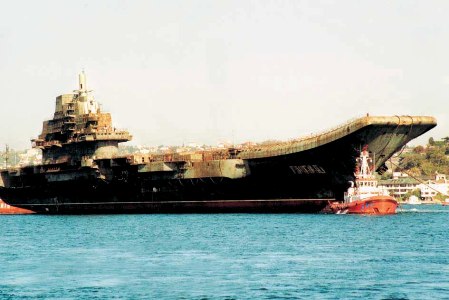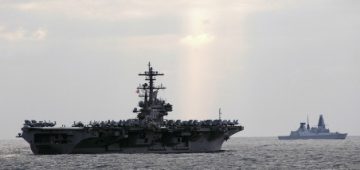COMMENTARY – Odin’s Eye


China means business in the world of carriers and naval aviation, and the surest sign is the revelation that nine top Chinese naval captains have been under training for the task for more than 20 years. They are now to take command in turn of the newly refurbished ex-Soviet Varyag, which is China’s first aircraft carrier and sailed for sea trials last month (Aug).
Bought from the Ukraine in 1998, but not delivered for a few more years, she is currently known as Training Vessel No 83, but will be used not just to train the ship’s crew but also school pilots and aviation support personnel. These people will also take to sea a new generation of Chinese home-built aircraft carriers. The steam-powered ship, which was sold as an empty shell, has been re-equipped with Chinese engines and radars, and just before departing for sea was seen raising steam, with radar aerials turning. Her new name, Shi Lang, is – ominously, perhaps – the name of a 17th Century admiral in the Manchu Navy who conquered Taiwan in 1681. While Chinese reports are adamant that Shi Lang is a training ship and has no combat role, nevertheless she reportedly has a complement of about 2,000 and can carry up to 30 Chinese J-15 fighters. The J-15 is similar to the Russian Sukhoi Su-33 and about equivalent to the American McDonnell Douglas F-18E/F Super Hornet. China is reportedly building two new aircraft carriers, based on the Varyag design, in Shanghai, and should by 2020 be able to deploy its first proper carrier air group. Strategists have long thought that China, the fabled ‘central kingdom’, could be a strong regional power, but had no global pretensions. Certainly a carrier battle group, added to China’s already impressive fleet, will easily enable the PLAN to dominate the seas around China, including those surrounding Taiwan. But the signs are that the Chinese are also thinking in terms of ocean-wide power projection. They have realised that with Yellow, East China and South China seas basins, not only do they have a total coastline of more than 10,000 km to defend, but also long, busy Sea Lines of Communication (SLOC) to secure. The Chinese economy depends on SLOC for the flow of materials into the country and the export of manufactured goods. Witness the fact that the Chinese Navy, operating in the Indian Ocean, has escorted more than 4,000 ships through the piracy-infested Gulf of Aden and the waters off Somalia. Nearly half of these ships have been non-Chinese. China has espoused international cooperation and peaceful development rather than “expansionism or hegemony.” A Chinese news agency claims: “The carrier programme will gear up China for a bigger role in peaceful cooperation worldwide …any misgivings or nervousness about China’s aircraft carrier programme is completely unnecessary.” Change the names and the speaker could be talking about the Royal Navy during its long period of hegemony, or the US Navy during the Cold War. This positive language from the Chinese, which shows their understanding of strategy and doctrine, contrasts sharply with what is happening to what was once the Anglo-Sphere naval alliance. For the moment at least the Royal Navy is much diminished by a British government which, it is widely recognised, doesn’t understand Defence and whose ‘soft power first’ policies could fairly be described as mind-bogglingly idiotic. What is happening in the USA and to the USN may be more significant. President Obama is right to think that the USA is still an AAA country, even though it has allegedly lost its AAA credit rating. However, since the Cold War the USN has shrunk from a 600-ship navy to a little more than 300 vessels and its budget has declined while operational demands have grown. Its Chief of Naval Operations has acknowledged that it must rely more in future on international partnerships, which is a tricky proposition as far as European navies are concerned. They suffer from serious under investment and while the UK is fielding new destroyers, attack submarines and at least one super-carrier, the force levels are pathetic and in no way meet Britain’s needs, never mind defending Europe or helping the Americans out. It seems the world balance of power is shifting decisively to the Far East, and, if not now, then sometime soon this will reach tipping point. The decline of the USN may be slow, inexorably taking place over 50 years rather than being a sudden falling away. The precise moment when its decline starts may be unclear, but just as in the 20th Century the USN gradually assumed the mantle from the Royal Navy as the ruler of the seven seas, so will the PLAN ascend to the top position to reflect the global economic predominance of China. One hundred years ago the RN’s Grand Fleet was being established as the most powerful destructive force on the face of the planet. In little more than a decade that magnificent force, which it could be argued ensured Germany could not win WW1, was being discarded wholesale. However, it was not clear that the Royal Navy had been deposed until half way through another world war when the US Navy’s new carrier strike groups took the war to Japan. China’s deploying of a carrier is very important, representing a clear statement of its aspirations to global reach and power projection. However, it is perhaps the rapid expansion of the PLAN’s submarine force that is most significant, for it can be argued that carriers will in any future major war in the Pacific or Indian Ocean, be nothing more than targets, soon going the way of the battleship into obsolescence. That moment is not here, yet, though and may be decades away, so in the meantime, if a nation wants to be a somebody on the global scene then it must have an aircraft carrier, or carriers.







Comments
Sorry, comments are closed for this item